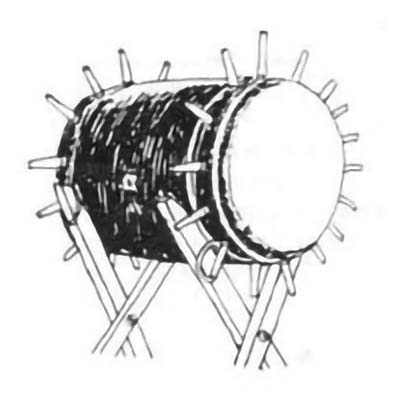The structure of the plug
79 views · Organized by 橘子猫 on 2022-02-10
The current plug is made by hollowing out a piece of red hair tree log, and it is cylindrical. Specifications vary.
Both ends of the drum frame are covered with untreated hairy yellow cowhide, the diameter of the drum surface is 40 cm to 80 cm, the height of the drum frame is 70 cm to 120 cm, and the thickness of the drum wall is 3 cm to 5 cm. Twelve or sixteen square wooden sticks hold the drumhead around its edges. The wooden stick is 30 cm long, thick at the top and thin at the bottom, and the thickest part is 4 cm square.
Once nailed, the sticks that expose the outside of the drum frame are 25 cm long. Viewed from both ends of the drum, the drum surface is like a red sun, and the wooden stick is like the light emitted by the sun, which has a strong original artistic beauty.
Therefore, people also call it the Keno Sun Drum. There are square sound holes on both sides of the drum body, one for the sound and the other for the rope. Some drums are also painted with red, white and black patterns. The drum is made of wood, the length of the drum is 30 cm, and the two ends of the wooden drum are spherical drum heads. The middle of the hand can be used for percussion.
Both ends of the drum frame are covered with untreated hairy yellow cowhide, the diameter of the drum surface is 40 cm to 80 cm, the height of the drum frame is 70 cm to 120 cm, and the thickness of the drum wall is 3 cm to 5 cm. Twelve or sixteen square wooden sticks hold the drumhead around its edges. The wooden stick is 30 cm long, thick at the top and thin at the bottom, and the thickest part is 4 cm square.
Once nailed, the sticks that expose the outside of the drum frame are 25 cm long. Viewed from both ends of the drum, the drum surface is like a red sun, and the wooden stick is like the light emitted by the sun, which has a strong original artistic beauty.

Therefore, people also call it the Keno Sun Drum. There are square sound holes on both sides of the drum body, one for the sound and the other for the rope. Some drums are also painted with red, white and black patterns. The drum is made of wood, the length of the drum is 30 cm, and the two ends of the wooden drum are spherical drum heads. The middle of the hand can be used for percussion.
Involving musical instruments
Saitu (pinyin: Sāi tǔ) is a musical instrument unique to the Jino people. It is made by hollowing out a piece of red hair tree log, and it is cylindrical. Specifications vary. Both ends of the drum frame are covered with untreated hairy yellow cowhide, the diameter of the drum surface is 40 cm to 80 cm, the height of the drum frame is 70 cm to 120 cm, and the thickness of the drum wall is 3 cm to 5 cm. Twelve or sixteen square wooden sticks hold the drumhead around its edges. The wooden stick is 30 cm long, thick at the top and thin at the bottom, and the thickest part is 4 cm square.
Guess you like
Organized by 苏肆 on 2022-02-10
Before the 1960s, the Jino people were still in the patrilineal clan rural commune stage at the end of the primitive commune society.
read >>
 渝公网安备 50010702504639号
渝公网安备 50010702504639号